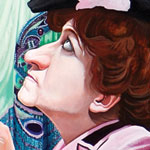
 (December 19, 1865 - February 14, 1932)
(December 19, 1865 - February 14, 1932)
"The great actors are the luminous ones. They are the great conductors of the stage"
- Minnie Maddern Fiske
Born in New Orleans on December 19, 1865, Mary or Marie Augusta Davey, later known as Minnie Maddern Fiske, was one of the first "realistic" actresses to grace the late nineteenth and early twentieth century American stage. Her career began in infancy, as both of her parents were "show-folks," and continued until her death of heart failure on Valentines Day in 1932. Her father, Tom Davey, was the manger of the St. Charles Theatre, and her mother, Lizzie Maddern, was an actress and musician who carried her young daughter on stage at the age of three in a production of Richard III as "the Duke of York." Shortly later her theatrical career exploded: she debuted in New York in A Sheep in Wolf's Clothing in 1870, then, at the age of five, began a decade of touring in roles such as "Little Eva" in Uncle Tom's Cabin and several other youthful roles, such as "Arthur" in King John.
Davey's more serious roles began upon her return to New York, where she played several 'ingenue' roles before being recognized and praised by renowned producer Daniel Frohman for her portrayal of the lead role, Stella, in the Lyceum Theatre's 1885 production of In Spite of All. In 1882 she married vaudeville musician Legrand White, but they divorced after only a few years; later, Davey married the critic and publisher of "The New Dramatic Mirror," Harrison Grey Fiske. Shortly thereafter she announced her retirement from the stage and began a career as a playwright. She wrote such successful and published plays as the one-act The Rose, based on her childhood in New Orleans; The Eyes of the Heart; and A Light from St. Agnes, which later was made into an opera.
Fiske's playwriting career gained the attention of actor James O'Neill, father of renowned modernist playwright Eugene O'Neill. Having been imprisoned, as he called it, by his recurring role in The Count of Monte Cristo, O'Neill asked that Minnie, now known simply as "Mrs. Fiske," write a play specifically for him, to release him of his stagnant role. Fiske and her husband collaboratively wrote Fontenelle which debuted in Chillicothe, Ohio in 1891. James O'Neill played the lead, and enjoyed audience praise of the role; however, the Fiskes felt that the play was empty and they lost interest in it.
Unable to resist the call of the stage, Mrs. Fiske retuned in what is seen as one of her finest and influential roles for "realistic" acting by women of her time, the role of "Nora" in Henrik Ibsen's A Doll's House in 1894; she then claimed an even larger success in the title role "Tess" in Tess of the D'Urbervilles in 1897. Her attention to "serious" roles, the preparation involved, and her focus on naturalism and simplicity in acting set her apart from most other actresses in the early twentieth century. Fiske once stated, "If it is a real part in a real play, that is the way to study it." Her devotion to a realistic approach to theatre was also evident in her opposition to the Theatre Syndicate, which she believed monopolized the American Theatre. Not relenting to commercialism, she did not consider herself above performing in small venues and even basement theatres.
Mrs. Fiske was also an advocate of animal rights. She detested the fact that animals were killed for fur and in hunting. The Toledo Blade reported that on a visit to Findlay, Ohio to perform her original play Leah Kleschna, Fiske stopped along the road to pick up a wounded puppy, took the dog to a vet, and paid for the expenses. However, shortly before the show she was accused by the local sheriff of dog napping! Finally, the incident was resolved, the sheriff humbly apologized, and her performance was widely praised and accepted by the Ohio audience.
Resources
Woollcott, Alexander. Mrs. Fiske: Her Views on the Stage. New York: Benjamin Blom, Inc., 1917, reissued 1968.
This book offers a candid, conversational view of what Mrs. Fiske deemed important in acting, the actor's development, and the American stage.
Binns, Archie. Mrs. Fiske and the American Theatre. New York: Crown Publishers, Inc., 1955.
This book offers a complete history of Minnie Maddern Fiske, her birth, life and death, and an extensive exploration of her theatrical career, including detailed accounts of productions and those she worked closely with. There are also several production photos with descriptions.
"Minnie Maddern Fiske." The Courier (Findlay, Ohio). History. http://www.the courier.com/Opinion/Historic/2001/Oct/ar_RL_101901.asp 10 Oct 2007.
"Minnie Maddern Fiske: Biography and Much More from Answers.com." http://www.answers.com/topic/fiske-minnie-maddern 10 Oct. 2007.
"Minnie Maddern Fiske (1865-1932)." Find a Grave Memorial. http://www.findagrave.com/cgi-bin/fg.cgi?page=gr&GRid=6274582 10 Oct 2007.
"Minnie Maddern Fiske." New York Public Library Digital Gallery. http://digitalgallery.nypl.org.